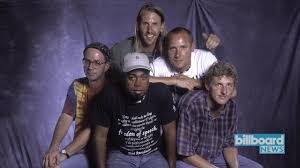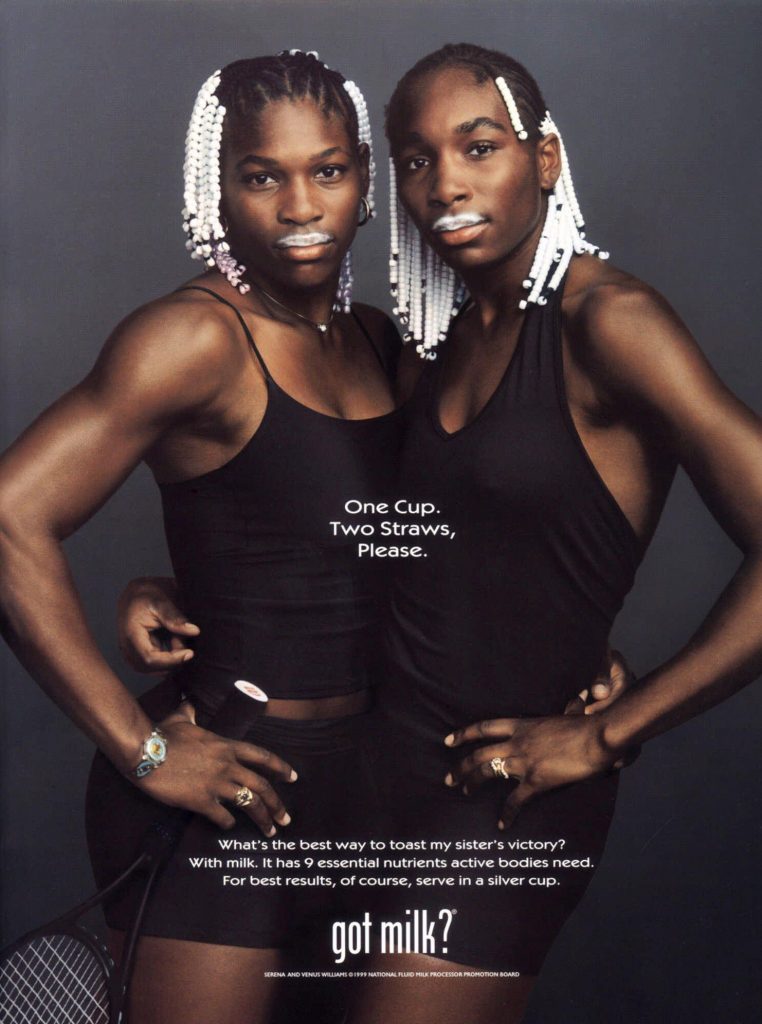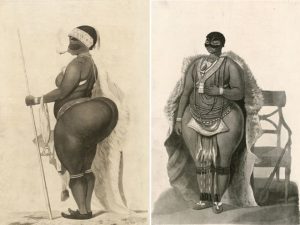Maybe we can’t change the world but
I wanna love you the best that…
…the best that I caaaaaannnnnnnnnnnnnnnnnnnnnnnnnn
– “Hold my Hand,” Cracked Rear View, Hootie and the Blowfish.
That’s the perfect blend of optimistic pessimism and cheerful apathy we’ve come to expect from the surprisingly successful “rock” band “Hootie and the Blowfish,” whose name was lit up in khaki-colored lights for some of the mid-90’s. The name of the band seemed enough of a reason to approach their music with caution, lest we caught Loser Cooties by being seen anywhere near the vicinity of their band, even just next to the CD at Sam Goody’s. But a stranger image stamped a large red “What The Hell” on everyone’s faces: why was some black guy wearing tan pants singing with those three white dudes in the back? Did they kidnap him and force him Rep for The Plaid? Was he mocking them for playing the gee–tar, and we’d soon hear the DJ’s (insert scratch noise here) and this dude would reappear in a Cadillac, sippin’ on ‘gnac? And why was his name “Hootie?” Was he a new addition to the Dungeon Family?
(Hootie Hooooooooooooooooooooooo!!!)
Darius Rucker, frontman of the band, later explained that he thought of the name “Hootie and the Blowfish” in college during a party: he saw one guy who wore glasses (and, thus, projected an owl-like demeanor) and another whose cheeks were puffy. He nicknamed the former “Hootie,” the latter “Blowfish,” and anointed them lead singers of hypothetical band, Hootie and the Blowfish. His dream became a reality when, just one week later, he and his friends started a band by the same name. (He says their exact response to his suggestion was: “Whatever.” Ironically, “Hootie” went on to halfway rename himself when he began a solo career as Darius Rucker, country musician, while his indifferent bandmates seemed destined to always, and only ever, be known simply as “The Blowfish.”)
The exact genre of the band’s music is the subject of much debate – pop, rock, pop rock, light country, pop country, country pop, pop grunge, happy grunge, dad rock, or toothless cousin folk? – and neither fans nor critics of it knew quite what to make of this “Hootie” or his band.
Rucker grew up in Charleston, South Carolina, in a home with his mother and a few siblings. He loved the radio and listened to all kinds of music. Whenever his older brother apparently teased him about listening to “white boy music,” his mother insisted he be allowed to listen to whatever he liked without grief from anyone else – though she did reportedly supplement his daily diet of musical mayonnaise with some Al Green.
A telling picture shown in a televised interview with Rucker and Dan Rather (of course, one of Rucker’s all-time heroes, representing warm American goodness with extra picked-from-George-Washington’s-own-cherry-tree cherries on top) finds a young Rucker, smiling, surrounded by a group of happy white children. Schools in his area had been integrated just after Rucker finished kindergarten, so though he lived in an all-black neighborhood, he didn’t experience the same culture shock his older siblings and friends did. He felt comfortable around his new white friends. During high school, he realized he loved to sing, joined a singing group, and started listening more closely to a variety of artists, becoming interested in Kenny Rodgers, Randy Foster, and Charley Pride, one of the few black country artists who was widely accepted by white audiences.
“Country Music Hall of Fame – Charley Pride”
“He was doing something he wasn’t supposed to do and proving everyone wrong,” he says to Rather, knowing the connections Rather must be making.
Rucker and his buddies found modest success in Charleston, but every now and then, they’d find themselves performing in a bar or venue that didn’t seem very welcoming of their color-blind inter…musical stylings. Rucker remembers developing extremely thick skin, determined (albeit in his signature sheepish-grin-shrugging-shoulders way) not to let some small-minded people stop him from making the music he liked. Nine years later, a label look a chance on “Hootie and the Blowfish,” and they soon found themselves playing on New York City radio stations and performing on David Letterman’s late night talk show. As they worked their favorite-worn-pair-of-jeans charm on America, they also faced some backlash, mostly in the form of spoofing or sarcastic teasing. But there were harsher critiques from fans of both Biggie and George Jones: no one seemed to know whom Hootie was repping for. Had Hootie lost his black card, or at least some points from it, for daring to put out what might effectively be called, “Nuthin’ but a Coon Thing, Baby?”
Hootie and the Blowfish – Live on The Late Show with David Letterman in 1995
But, surprise! It turns out Darius Rucker only knew what many had forgotten: that slightly country sound, the one that runs through his music, the one he’s constantly mocked for singing, has its roots in black culture, just like pretty much everything else that’s actually good about America.
The music industry was largely responsible for how music was marketed to audiences of different colors and how country music came be identified as “white” music despite sharing much of its genetic makeup with the blues tradition, which is decisively black and also the precursor rhythm ‘n blues, rock ‘n roll, psychedelic rock, heavy metal, and even rap beats. As a result of exploitation and appropriation, country music failed to accurately represent any of the cultural intermixing that occurred in the nascent stage of this genre’s development.
Brief Peek into Country Music’s African-American Roots:
“African-American Influence Part of Country Music’s Legacy”
Black Artists Whose Work Shaped Country (and, really, American) Music:
Bessie Smith – “Nobody Knows You When You’re Down and Out”
Little Brother Montgomery – “Riverside Boogie”
T-Bone Walker – “Don’t Throw Your Love on Me So Strong”
“Muddy Waters, Buddy Guy & Junior Wells – ‘Hoochie Coochie Man’ & ‘Mannish Boy'”
Darius Rucker is, and has been, one of the few country musicians of color to have a lengthy career, and though he was originally teased for not being “black enough” and selling out to white country audiences, I posit he’d receive more support if he debuted today. “Hootie and the Blowfish” was not a bona fide country band, but in the intimidatingly talented shadow of new artists who dominated the 90’s music scene with rap, alt rock, and grunge, all languages that seemed to en-trance young people who hungered for words to put to their rage and their pent up energies, Hootie’s light seemed to shine on older, less hip crowds who had settled into routines of adult life that made young rage look not only pointless but tiring.
Additionally, rap music and grunge rock are often committed to portraying a certain authenticity – those artists don’t hide their dark, violent feelings or the grim realities of life. But black audiences, and even certain white ones, have always craved and prized authentic expressions, starting with “Negro” folk music of the early twentieth century, which were rerecorded but unsuccessfully marketed to black listeners because, according to black vaudevillian artist Perry Bradford, they didn’t sound right:
“There’s fourteen million Negroes in our great country and they will buy something if recorded by one of their own because we are the only folks that can sing and interpret hot jazz songs just off the griddle correctly” (Keyes 112).
Rucker’s response to haters echoed that call for authenticity: “I mean, it was better to be honest.”
“Hootie and the Blowfish,” then, was also just trying to keep it real. As a child, Rucker dreamed of leaving Charleston for the big city of New York, NY London, England Paris, France Columbia, SC, but after living there for several years, he couldn’t shake the urge to go back home, physically, emotionally, and apparently culturally. It’s hard to “Hootie and the Blowfish” as anything more than a feel-good memory of pre-Trump America, but after learning that Darius Rucker might actually be the keeper of one of black music’s lesser known traditions, it’s hard not to think of him as the hero some people really needed, one who could interpret country music’s “real” soul and serve it hot and fresh off that metaphorical griddle. Perhaps the 90’s should’ve have allowed poor “Hootie” — sigh, fine, Darius Rucker — to just let him do him. Although, that glint in his non-threatening eye has always said: Let the Haters Cry.
— Radhika Nataraj
Works Cited
- “Darius Rucker.” The Big Interview with Dan Rather. AXS TV, 21 Apr. 2014.
- Dre featuring Snoop Doggy Dogg. “Nuthin’ but a ‘G’ Thang.” The Chronic, Death Row, 1992.
- Hootie and the Blowfish. “Hold My Hand.” Cracked Rear View, Atlantic, 1994.
- —. “Let Her Cry.” Cracked Rear View, Atlantic, 1994.
- Keyes, Cheryl L. “The Aesthetic Significance of African-American Sound Culture and Its Impact on American Popular Music Style and Industry.” The World of Music, vol. 45, no. 3, 2003, pp. 105-29.
- Lewis, George H. “The Color of Country: Black Influence and Experience in American Country Music.” Popular Music and Society, pp. 107-19.
- “Hootie Hoo.” Southernplayalisticadillacmuzik, LaFace, 1994.







